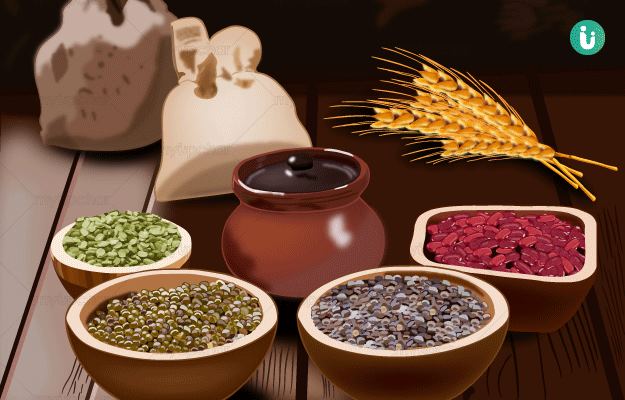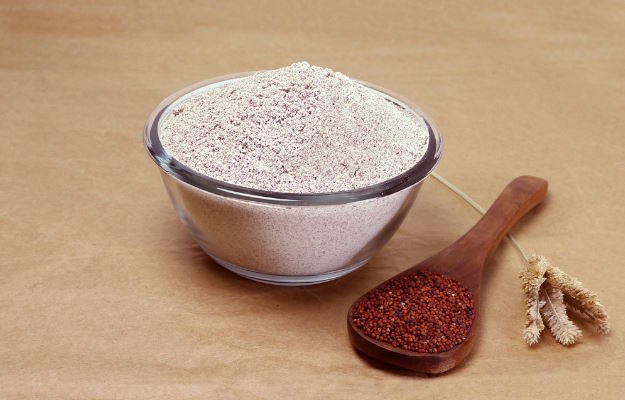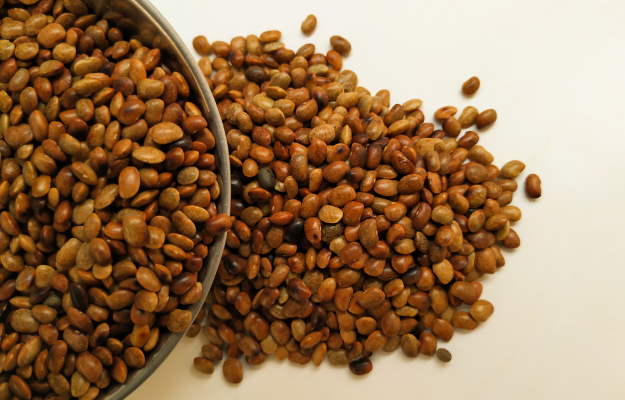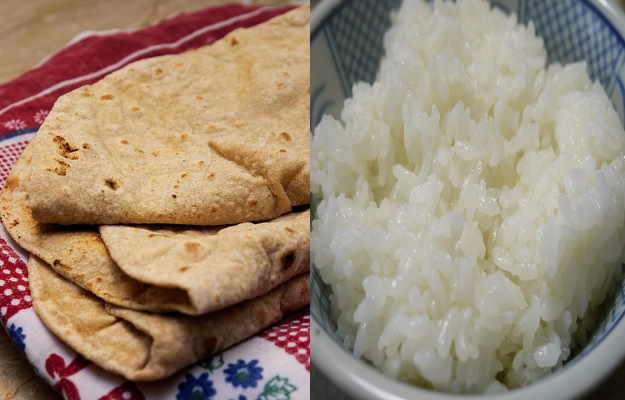Grains are the harvested seeds of grasses. Some grains - like rice, wheat, corn, and oats - are a staple food across the globe. It is an established fact that grains are a good source of complex carbohydrates.
Grains can be available in the form of cereals and legumes. Whole grains are the healthiest kind of grain and contain protein, fibre, iron, magnesium, copper, zinc, manganese, selenium and various vitamins of the vitamin B family.
Since grains are high in fibre, they make you feel full and satisfied for a longer period of time, thus helping in weight loss. Various studies have concluded that grains not only maintain body weight but also lower the risk of heart disease, diabetes and various other systemic diseases.
Grains are not only consumed by humans but are also used to feed livestock.
Read more: What to eat and what not to eat for weight loss
Troubled by obesity? Failed to lose weight? Now control weight easily by myUpchar Ayurveda Medarodha Weight Control Tablet. Get started today and take steps towards a healthy life.
- Types of grains
- Nutritional value of grains - Grains good for health in Hindi
- Benefits of grains
- Side effects of grains
- How to use grains
Types of grains
There are three categories in which grains can be classified:
- Cereal grains: Wheat, maize, rice and barley are the world’s four major cereal grains that make up the bulk of food supply to humans. Cereals can be further classified into whole grains and refined grains.
- Legumes: Legumes are the seeds or pulses, that are harvested from plants.
- Gluten-free grains: Gluten is an important part of grains as it gives elasticity to the dough of many grains like wheat and barley. Despite its benefit, it can create a problem for people with wheat allergies and other forms of gluten intolerance.
Cereal grains and refined grains
As the name suggests, whole grains are the ones which are unprocessed and still contain all three parts of the grain, that is:
- Bran: The outer hard shell of the grain is called bran. It is the part of the grain that provides the most fibre and most of the B vitamins and minerals.
- Germ: The germ is the next layer and is packed with nutrients including healthy fatty acids and vitamin E.
- Endosperm: The endosperm is the soft part in the centre of the grain. It contains the starch.
Whole grain means that the entire grain kernel is in the food. They are very nutritious: whole grains are better sources of fibre and other important nutrients, such as selenium, potassium and magnesium, than refined flours. Because the grain’s kernel is not removed, whole grains contain more protein and fibre, but can also contain a bit more fat.
Whole grains include:
- Rice
- Amaranth
- Barley
- Brown rice
- Buckwheat
- Cracked wheat
- Flaxseed
- Grano
- Millet (little millet, pearl millet, finger millet, barnyard millet, Kodo millet)
- Oats
- Popcorn
- Quinoa
- Sorghum
- Wheat berries
- Whole grain barley
- Whole rye
Refined grains
Grains are often milled for better handling, easier storage and longer shelf life. In the milling process, the bran and germ of the grain are removed. While this does make the grains easier to work with, it also removes some of the nutrition. Refined grains have less dietary fibre, protein, iron, and vitamins as compared to whole grains.
Forms of refined grains found in kitchens around the world include:
- White rice
- Pasta
- White bread
- Corn flakes
- Couscous
- Noodles
Enriched grains
These are refined grains that are fortified with minerals such as iron and vitamins to restore some of the nutritive value lost during milling.
Legumes
Legume grains or legumes are an important part of the Indian meal. They include a wide variety of lentils and beans which are high in iron, folate (vitamin B9), vitamin B and protein. They are easily available in the market.
The list of nutritious and easily available legumes in India includes black grams (kali urad dal), green peas, black-eyed peas (raungi), pinto beans (rajma chitra), split peas (matar, often used in the street food dish kulcha-matar), soybeans, mung beans, azuki red beans (also known as red cowpea), fava beans (baakla), garbanzo beans (chole), kidney beans (rajma), lima beans (sem ki phali), white beans, and more.
Other types of legumes are lentils, peas and nuts such as peanuts.
Gluten-free grains
As of 2018, around 2% of the global population suffers from Celiac disease. When someone with this autoimmune disease consumes gluten, it damages their intestines. People with gluten or wheat allergy can consume grains which are gluten-free but have the same amount of nutritive value in them.
Gluten-free grains include:
- Amaranth (Rajgira atta)
- Buckwheat (Kuttu ka atta)
- Corn (makki or makai)
- Millet (bajra, ragi, kangni, etc.)
- Oats
- Quinoa
- Rice
- Sorghum (jowar)
- Teff
- Wild rice (jhangora)
Nutritional value of grains - Grains good for health in Hindi
Grains are said to have a high amount of fibre in them. Apart from fibres, grains are rich in carbohydrates, proteins, iron, magnesium, iodine, and phosphorus. Grains are also a rich source of vitamins like vitamin B1 (thiamine), B2 (riboflavin), B3 (niacin), B6 (pyridoxine) and B9 (folic acid).
The most commonly consumed grains, cereal grains are a rich source of carbohydrate, protein, fibre, vitamins and minerals. They are also low in fat.
Read more: Calories counter for Indian breads
Benefits of grains
Grains are not only nutritious but are also delicious. Various doctors and nutritionists recommend the inclusion of a variety of grains in the diet. The following are some of the benefits you can reap from eating adequate amounts of grains daily:
Grains help in weight loss
Grains like whole wheat and brown rice are rich in plant proteins and fibres. They have the ability to keep you full for a longer period of time as they have a low glycaemic index - this means they maintain the blood sugar level rather than causing a spike when you eat them and a sudden drop a few hours later. Since you feel satiated for long, your appetite reduces and you snack less. This helps in losing weight and also improves the digestive system.
Grains help in reducing constipation
There are two types of fibre, both of which help to prevent and treat constipation. Soluble fibre allows more water to remain in the stool, making it softer and easier to pass through the intestines. Insoluble fibre adds volume to the faeces, thus accelerating its passage through the gut and preventing constipation.
Whole grain products like whole-wheat bread and pasta, bran flake, oatmeal and legumes like lentils, chickpeas, black beans, kidney beans, and soybeans are rich sources of fibre.
Grains help in reducing high blood pressure
A study published in the American Journal of Clinical Nutrition found that eating three portions of whole-grain foods per day reduces the risk of high blood pressure. The study was conducted by Scottish scientists on more than 200 participants. One set of participants were given whole-grain food like wheat and oats to eat, while the other set was fed with refined grains like refined cereals and white bread. The result showed a substantial decrease in blood pressure of those who were on a whole-grain diet. Reportedly, the participants on a whole-grain diet experienced a reduction of 5-7 mm Hg in blood pressure during the study.
Blood pressure is measured in millimetres of mercury or Hg; 120/80 mm of Hg is considered to be normal blood pressure and anything over 140/90 is considered to be hypertension.
Grains reduce the risk of heart disease
According to research by the Harvard School of Public Health in Boston, US, eating 90 grams or three servings of whole grains every day reduces the risk of heart diseases by 15%. All three parts of the whole grains keep the arteries healthy. The whole-grain foods good for the heart are dark bread, brown rice, toasted wheat cereals, and oatmeal.
Grains help in reducing the risk of type-2 diabetes
Studies have shown that the fibre in whole grains helps with insulin sensitivity in the body. Since fibre takes time to break down, whole grains do not cause a sudden increase in glucose levels in the blood - unlike refined grains which can cause a spike in blood sugar levels. As a result, fibre stabilizes blood sugar and delivers glucose to the blood in small amounts.
Refined grains present in foods like sweets, pastries, white bread and white rice can suddenly spike blood sugar. Remember that while eating whole grains and cutting back on refined grains can help you prevent diabetes, it is not a substitute for medicine if you already have diabetes.
Grains lower the risk of developing colorectal cancer
According to the American Institute for Cancer Research and the World Cancer Research Fund, eating three portions (90 grams) of whole grains like brown rice or whole wheat bread daily reduces the risk of colorectal cancer by 17%. Further, they have stated, the more whole grains you eat, the lower the risk gets. They found that the fibre content in whole-grain foods is the key factor for the decrease in the risk of cancer.
Grains reduce the risk of stroke
Whole-grain foods are known to benefit cardiac health by reducing blood pressure, improving lipid levels, and maintaining blood glucose levels and insulin metabolism. Whole-grain foods are rich in antioxidants, thus they prevent chronic inflammation and cellular damage.
A study conducted on the effect of whole grains on ischemic stroke concluded that the consumption of whole-grain cold breakfast cereal and bran led to a decrease in the risk of ischemic stroke. However, the same study added that increased intake of regular popcorn leads to an elevated risk of developing an ischemic stroke.
Side effects of grains
Grains can worsen the symptoms of irritable bowel syndrome
Irritable Bowel Syndrome (IBS) is a gastrointestinal (GI) disorder marked by repeated pain and bloating in the abdomen.
A person living with IBS may also suffer from diarrhoea or constipation. Eating whole grains which contain gluten may cause intestinal damage in people with IBS.
Gluten in the whole grains triggers an autoimmune response that damages the lining of the small intestine. In sever cases, even a small crouton can cause trouble in their digestive tract.
Effect of grains on gluten intolerance
People with gluten intolerance cannot consume grains as it would induce digestive problems such as bloating, abdominal pain or diarrhoea in them. Gluten intolerance is sometimes confused with Celiac disease, but it does not affect the intestines in the same way.
Of course, people with this condition can safely consume gluten-free grains like rice, oats, teff and quinoa.
Grains can make Celiac disease symptoms worse
Celiac disease is an autoimmune disease which gets activated on eating food with gluten - this includes whole grains like wheat. As soon as a person with Celiac disease ingests gluten, their body triggers the immune system to damage the small intestine. Celiac disease increases the risk for other conditions like osteoporosis and malnutrition.
How to use grains
These are the different ways in which grains can be used:
- One of the easiest ways of introducing grains in your diet is by eating popcorn. Do not add salt or caramel to your popcorn to avoid high salt and high sugar intake.
- You can include whole-grain cereals like bran flakes, shredded wheat or oatmeal in your breakfast.
- A basic legume salad can be made from a combination of any kind of cooked legumes, together with chopped herbs, lemon, olive oil, salt, and pepper.
- Rather than having plain toast, you can have whole-wheat toast with baked beans or daal.
- Pastries and cakes can be replaced by home-baked low-fat bran muffins.
- Substitute white rice with delicious brown rice, wild rice or bulgur wheat (daliya).
- Rather than using white bread, you can make sandwiches using whole-grain bread.
- You make legume sprouts with green grams (mung daal). They are utterly delicious and also highly nutritious.
- Wild rice can be an amazing addition to your regular soups and salads.
- Oats and crushed bran cereals can substitute dry bread crumbs.






















